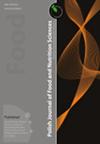Drying Kinetics and Changes of Total Phenolic Content, Antioxidant Activity and Color Parameters of Mango and Avocado Pulp in Refractance Window Drying
IF 2.3
4区 农林科学
Q3 FOOD SCIENCE & TECHNOLOGY
引用次数: 8
Abstract
Refractance window drying is an innovative technology belonging to the fourth generation of drying technologies that could enhance the quality of the dried product and improve the drying process. In this study, two factors with the type of fruit pulps (avocado and mango) and drying tempera - ture (ranging from 80 to 95°C) were investigated. Results showed that in refractance window drying, the evaporation process rapidly occurred, mainly in the falling-rate period with undetectable constant-rate period. The Weibull was the best fit model among eight investigated mathematical models that could determine the drying behavior. The effective diffusivity was found to be from 4.25×10 -10 m 2 /s to 7.24×10 -10 m 2 /s for avocado pulp, and from 4.50×10 -10 m 2 /s to 10.67×10 -10 m 2 /s for mango pulp when the drying temperature was changed from 80 to 95°C. Moreover, the corresponding activa - tion energy was 32.06 and 66.03 kJ/mol for avocado and mango pulp moisture evaporation, respectively, and the highest quality of powders of both dried pulps was obtained after processing at 90°C. The refractance window drying revealed a high potential in the production of fruit powders from avocado and mango due to the high retention of more than 80% of total phenolic content (TPC) and antioxidant activity. TPC could be used as a useful criterion for the evaluation of the drying process in terms of dried product quality.芒果和鳄梨果肉在折光窗干燥过程中的干燥动力学及总酚含量、抗氧化活性和颜色参数的变化
折光窗干燥是第四代干燥技术中的一项创新技术,可以提高干燥产品的质量,改善干燥过程。研究了果肉类型(牛油果和芒果)和干燥温度(80 ~ 95℃)的影响因素。结果表明,在折光窗干燥中,蒸发过程发生迅速,主要发生在下降速率期,而恒定速率期无法检测到。威布尔模型是八种确定干燥行为的数学模型中最适合的模型。当干燥温度为80 ~ 95℃时,牛油果浆的有效扩散系数为4.25×10 ~ 7.24×10 ~ 10m 2 /s,芒果浆的有效扩散系数为4.50×10 ~ 10m 2 /s。牛油果和芒果果肉水分蒸发的活化能分别为32.06 kJ/mol和66.03 kJ/mol,在90℃条件下处理后的果肉粉质量最高。折光窗干燥法在牛油果和芒果果粉的生产中具有很高的潜力,因为它保留了80%以上的总酚含量(TPC)和抗氧化活性。TPC可以作为干燥过程中干燥产品质量评价的有用标准。
本文章由计算机程序翻译,如有差异,请以英文原文为准。
求助全文
约1分钟内获得全文
求助全文
来源期刊

Polish Journal of Food and Nutrition Sciences
FOOD SCIENCE & TECHNOLOGY-
CiteScore
4.30
自引率
12.50%
发文量
25
审稿时长
20 weeks
期刊介绍:
The Polish Journal of Food and Nutrition Sciences publishes original, basic and applied papers, reviews and short communications on fundamental and applied food research in the following Sections:
-Food Technology:
Innovative technology of food development including biotechnological and microbiological aspects
Effects of processing on food composition and nutritional value
-Food Chemistry:
Bioactive constituents of foods
Chemistry relating to major and minor components of food
Analytical methods
-Food Quality and Functionality:
Sensory methodologies
Functional properties of food
Food physics
Quality, storage and safety of food
-Nutritional Research Section:
Nutritional studies relating to major and minor components of food (excluding works related to questionnaire
surveys)
-“News” section:
Announcements of congresses
Miscellanea
 求助内容:
求助内容: 应助结果提醒方式:
应助结果提醒方式:


